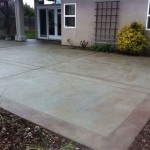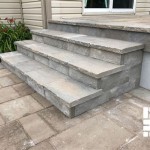How To Install 12x12 Patio Pavers
Installing a patio using 12x12 pavers can significantly enhance the aesthetic appeal and functionality of an outdoor space. This project, while achievable for many homeowners, requires careful planning, precise execution, and a thorough understanding of the materials and steps involved. This article provides a comprehensive guide to installing 12x12 patio pavers, detailing the necessary preparations, installation techniques, and essential tools.
The success of any paver installation hinges on a solid foundation. A poorly prepared base will inevitably lead to uneven surfaces, shifting pavers, and premature deterioration of the entire patio. Therefore, investing time and effort in creating a stable and well-drained base is paramount.
Planning and Preparation: The Foundation of a Durable Patio
Before commencing any physical work, meticulous planning is essential. This involves determining the patio's size and shape, assessing the existing soil conditions, calculating material quantities, and acquiring the necessary tools and equipment. A well-defined plan minimizes errors and ensures a smooth installation process.
The initial step is to define the patio area. Use stakes and string to mark the perimeter of the desired patio. Ensure the shape is accurate and aligns with any adjacent structures, such as the house or garden beds. Consider the intended use of the patio and choose a size accordingly. Walk the area and visualize the finished space before finalizing the dimensions.
Next, evaluate the existing soil conditions. Understanding the soil composition is crucial for determining the appropriate base materials and drainage requirements. Soil types vary widely, ranging from sandy soils that drain easily to clay soils that retain moisture and expand and contract with changes in weather. Perform a percolation test to assess the soil's drainage capacity. Dig a hole approximately 12 inches deep and fill it with water. Observe how quickly the water drains away. Slow drainage indicates the need for enhanced drainage solutions, such as the installation of a drainage system or the use of more granular base materials.
Calculate the required materials based on the patio's dimensions and the depth of the base layers. Accurate material calculations prevent shortages or excess materials, saving time and money. The following materials are typically required:
- 12x12 patio pavers: Calculate the number of pavers needed based on the patio's square footage, adding approximately 5-10% for cuts and breakage.
- Base material (crushed stone or gravel): Typically requires a 4-6 inch compacted layer. Calculate the volume of base material needed by multiplying the patio's area by the desired base depth.
- Sand (for leveling): Use coarse sand for the leveling course. A 1-inch layer is typically sufficient. Similar to the base material, calculate the sand volume by multiplying the patio's area by the desired sand depth.
- Edging material (paver edging, landscape blocks, or similar): Choose an edging material that complements the pavers and prevents them from shifting. Calculate the length of edging needed based on the patio's perimeter.
- Joint sand (polymeric sand): This sand is used to fill the joints between the pavers, stabilizing them and preventing weed growth. Calculate the amount of joint sand needed based on the paver's surface area and joint width.
Gather all necessary tools and equipment before starting the project. Having the right tools readily available simplifies the installation process and ensures professional results. Essential tools include:
- Shovels and rakes: For excavating and spreading base materials.
- Wheelbarrow: For transporting materials.
- Compactor (plate compactor): For compacting the base layers. This is crucial for creating a stable foundation.
- Level: For ensuring a level surface. A long level is recommended for larger patios.
- Measuring tape: For accurate measurements.
- String and stakes: For marking the patio perimeter.
- Rubber mallet: For setting the pavers in place.
- Circular saw with a diamond blade or paver splitter: For cutting pavers to fit edges and corners.
- Gloves and safety glasses: For personal protection.
- Broom: For sweeping joint sand into the paver joints.
- Garden hose with a spray nozzle: For wetting down polymeric sand.
Installation Process: Laying the Foundation and Setting the Pavers
Once the planning and preparation are complete, the actual installation process can begin. This involves excavating the patio area, building the base layers, laying the pavers, and filling the joints. Each step requires careful attention to detail to ensure a durable and aesthetically pleasing patio.
Excavate the patio area to a depth that accommodates the base layers, sand leveling course, and paver thickness. The excavation depth should be approximately 8-10 inches below the desired finished grade. Remove all vegetation, topsoil, and debris from the excavation area. Ensure the excavation has a slight slope (approximately 1/4 inch per foot) away from the house to facilitate proper drainage.
Install the edging material along the perimeter of the excavated area. Secure the edging firmly in place using stakes or concrete adhesive, depending on the type of edging material used. The edging provides a visual border and prevents the pavers from shifting outwards over time. Ensure the edging is level and flush with the surrounding ground.
Apply the base material in layers, compacting each layer thoroughly. The base material provides a stable and well-drained foundation for the pavers. Spread the base material evenly over the excavated area, using a rake to distribute it uniformly. Compact the base material using a plate compactor. Compact in multiple passes, overlapping each pass to ensure complete compaction. Add additional layers of base material as needed, compacting each layer until the desired base depth is achieved. A compacted base depth of 4-6 inches is generally recommended.
Spread a 1-inch layer of coarse sand over the compacted base material. This sand layer serves as a leveling course, providing a smooth and even surface for the pavers to rest on. Use a rake to spread the sand evenly, ensuring it is free of clumps and debris. Screed the sand layer using a screed board or a long, straight board. The screed board should be slightly wider than the patio area. Drag the screed board across the sand, using the edging as a guide, to create a level and uniform surface. Periodically check the sand layer with a level to ensure it is perfectly level. Fill any low spots with additional sand and re-screed the area.
Lay the 12x12 pavers on the prepared sand bed. Begin laying the pavers from one corner or edge of the patio, working systematically across the entire area. Place each paver firmly on the sand, ensuring it is level and aligned with adjacent pavers. Use a rubber mallet to gently tap the pavers into place. Maintain consistent spacing between the pavers, typically around 1/8 to 1/4 inch. Use paver spacers or a string line to ensure uniform spacing. If necessary, cut pavers to fit around edges and corners using a circular saw equipped with a diamond blade or a paver splitter. Wear safety glasses and gloves when cutting pavers. After laying a section of pavers, check the level and alignment of each paver. Make any necessary adjustments by adding or removing sand beneath the paver.
After all the pavers are laid, sweep polymeric sand into the joints between the pavers. Polymeric sand is a special type of sand that contains polymers that bind together when wetted, creating a strong and durable joint. Sweep the sand thoroughly into all the joints, ensuring they are completely filled. Use a soft-bristled broom to avoid scratching the paver surface. Remove any excess sand from the paver surface.
Lightly mist the paver surface with water to activate the polymeric sand. Use a garden hose with a spray nozzle to apply a gentle mist of water to the paver surface. Avoid over-watering, as this can wash away the polymeric sand. Allow the polymeric sand to dry and harden according to the manufacturer's instructions. Typically, it takes 24-48 hours for the polymeric sand to fully harden.
Addressing Common Challenges and Ensuring Long-Term Durability
Even with careful planning and execution, paver installations can present certain challenges. Understanding these challenges and implementing appropriate solutions is crucial for ensuring the long-term durability and aesthetic appeal of the patio.
One common challenge is uneven settling of pavers. This can occur due to inadequate base compaction, poor drainage, or unstable soil conditions. To prevent uneven settling, ensure the base layers are thoroughly compacted using a plate compactor. Improve drainage by installing a drainage system or using more granular base materials. If pavers do settle unevenly, they can be re-leveled by removing the paver, adding or removing sand beneath it, and re-setting the paver. Regularly inspect the patio for signs of settling and address any issues promptly.
Another challenge is weed growth between the pavers. Weeds can detract from the appearance of the patio and can eventually destabilize the pavers. Polymeric sand helps to prevent weed growth by creating a dense and impenetrable joint. However, weeds can still sprout in areas where the polymeric sand is damaged or missing. To control weed growth, regularly sweep the patio and remove any weeds that appear. Apply a weed killer specifically designed for use on paver patios. Re-apply polymeric sand to any areas where it is damaged or missing.
Proper maintenance is essential for preserving the appearance and longevity of the paver patio. Regularly sweep the patio to remove dirt, debris, and leaves. Hose down the patio periodically to remove stains and spills. Use a paver cleaner specifically designed for cleaning paver patios. Avoid using harsh chemicals or abrasive cleaners, as these can damage the paver surface. Seal the pavers with a paver sealer to protect them from staining, fading, and weathering. Re-apply the sealer every 2-3 years, or as needed, to maintain the paver's appearance and durability.
Installing 12x12 patio pavers is a rewarding project that can enhance the beauty and functionality of an outdoor space. By following the steps outlined in this guide and paying careful attention to detail, homeowners can create a durable and aesthetically pleasing patio that will provide years of enjoyment.

Paver Installation Materials Tools And Process Plant Design Group

Patio Pavers Peachtree City Hardscape Patios Fayetteville Ga Landscape Innovations

How To Install A Beautiful Decomposed Granite Patio South House Designs

Cambridge Pavingstones Offer Do It Yourself Pavement System For Your Driveway Pool Deck Patio Or Sunroom Thereporter

Havenbrick Pavers Best Bricks Adelaide Concrete

Premium Blend Pavers Best S Exclusice

Premium Blend Pavers Best S Exclusice

Stradapave Pavers Budget Adelaide Concrete

Flagstone Pavers Best S Adelaide

2024 Paver Patio Cost Installation Costs
Related Posts








